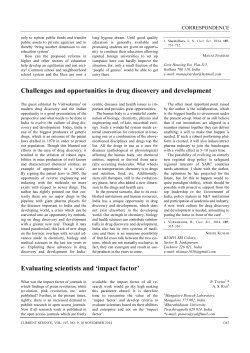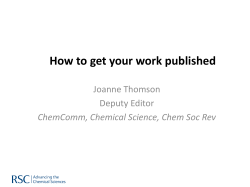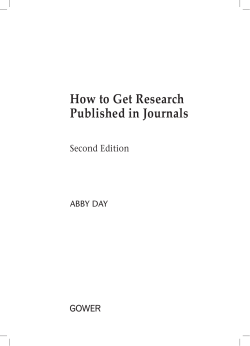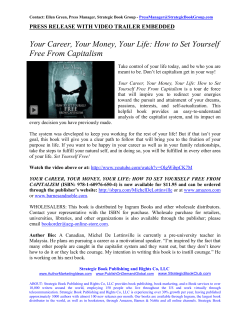
Open access: changing the way chemistry is published
Bailey Fallon Chemistry Central, London WC1X 8HL, UK E: bailey.fallon@chemistrycentral.com Open access: changing the way chemistry is published What is open access (OA) journal publishing? Open access is not self-publishing, nor a means to bypass peer review • Free and permanent unrestricted online access to peer-reviewed articles • Increased visibility for articles and increased potential citations • Authors retain copyright to their work • Data can be redistributed, reused and translated freely Open access vs. subscription journal publishing process Open access journal Submission of manuscript to journal Peer review Acceptance Article-processing charge Publication of article Subscription journal Publication of article Subscription charge access Open access journals maintain rigorous peer review standards Open access journals: the benefits Authors Researchers Institutions Funders increased visibility for articles, potential citations and collaboration opportunities as access barriers are removed. Copyright retained. No barriers to accessing content. OA enhances free flow of results and ideas. Researchers can reuse and share data from OA articles Cost of publishing coupled to research output. Data can be placed in institutional repositories for enhanced dissemination. Free access to data from funded research. Ability to analyse effectiveness of grants more easily Educators Creative Commons licence allows for reuse of data. OA data can freely be used for course materials 20 Public and special interest groups Developing countries and small institutions Unhindered access to research funded through their taxes Free access to latest results improves quality of research, and prevents “reinventing the wheel” Open access to all readers OA means free access, wider dissemination and increased citation opportunities19 while subscription charges act as a barrier to access Subscription journals: the drawbacks Access and copyright barriers Authors give up control of their research to the publisher before buying it back through subscription charges The growth of open access www.jcheminf.com Christoph Steinbeck (EBI) David Wild (Indiana University) Covers cheminformatics and molecular modelling Indexed by: Scopus, PubMed, PubMed Central, Google Scholar Editors-in-Chief: Piet Herdewijn (Universiteit Leuven) Sijbren Otto (University of Groningen) Günter von Kiedrowski Editor-in-Chief: 1.31 R. Stephen Berry (Univ. of Chicago) www.journal.chemistrycentral.com Editors-in-Chief: Covers all areas of chemistry in 8 subject sections, each led by a group of Section Editors: • Organic chemistry • Inorganic chemistry • Physical chemistry • Biological chemistry • Analytical chemistry • Environmental chemistry • Materials and polymers • Food science Indexed by: PubMed, PubMed Central, Web of Science, CABI, CAS, Scopus, Google Scholar 2.35 www.geochemicaltransactions.com Ken B. Anderson (S. Illinois Univ. Carbondale) Gregory Druschel (University of Vermont) Carla Koretsky (Western Michigan Univ.) The official journal of the ACS Geochemistry Division Indexed by: PubMed, PubMed Central, Web of Science, CABI, CAS, GeoRef, Scopus, Google Scholar REFERENCES 1 http://arxiv.org/ 2 http://www.ncbi.nlm.nih.gov/pubmed 3 http://www.arl.org/sparc/ 4 http://www.openarchives.org/ 5 http://www.biomedcentral.com/ 6 http://www.ncbi.nlm.nih.gov/pmc/ 7 http://www.plos.org/ 8 http://www.soros.org/openaccess 9 http://www.earlham.edu/~peters/fos/bethesda.htm 10 http://www.zim.mpg.de/openaccess-berlin/berlin_declaration.pdf 11 http://www.openrepository.com/ 12 http://pubchem.ncbi.nlm.nih.gov/ 13 http://www.wellcome.ac.uk/About-us/Policy/Spotlight-issues/Open-access/Policy/index.htm 14 http://www.chemistrycentral.com/ 15 http://www.chemspider.com/ 16 http://www.oaspa.org 17 http://www.biomedcentral.com/info/authors/oawaiverfund/ 18 http://www.arl.org/sparc/advocacy/frpaa/index.shtml 19 Gargouri Y, Hajjem C, Larivière V, Gingras Y, Carr L, et al. (2010) PLoS ONE 5(10): e13636. doi:10.1371/journal.pone.0013636 20 http://creativecommons.org 21 http://www.arl.org/bm~doc/arlstat08.pdf 22 http://www.sherpa.ac.uk/juliet/index.php 23 http://www.doaj.org/ 24 Björk B-C, Welling P, Laakso M, Majlender P, Hedlund T, et al. (2010) PLoS ONE 5(6): e11273. doi:10.1371/journal.pone.0011273 25 http://www.jcheminf.com/content/1/1/2 26 http://www.chemistrycentral.com/images/leaflets/201007_Trifold%20OA%20Leaflet_cropped.pdf 2000: PubMed Central: free archive of full text versions of biomedical literature.6 2001: PLoS (Public Library of Science): non-profit, project aimed at creating a library of OA journals7 2003: Berlin Declaration on Open Access to Knowledge in the Sciences and Humanities10 2004: Launch of Open Repository11 2004: Release of PubChem: a free resource that provides information on the biological activities of small molecules12 3500 3000 2500 500 0 Total monthly submissions to OA journals published by BioMed Central and Chemistry Central 6000 4000 2005: Wellcome becomes first funder to introduce mandatory open access policy13 2006: Launch of Chemistry Central14 2000 2007: ChemSpider launched15 0 Number of titles listed in the Directory of Open Access Journals23 including 127 chemistry journals in 2010. About 20% of all peer reviewed articles are now open access24 (Ruhr-Universität Bochum) Covers experimental and theoretical studies of complex molecular networks. 1999: BioMed Central launches OA journals5 4000 1000 Editors-in-Chief: 1999: Open Archive Initiative: aims to build a low-barrier framework for digital, institutional repositories4 2003: Bethesda Statement on Open Access Publishing9 1500 Chemistry Central (www.chemistrycentral.com) is an open access journal publishing platform, launched in 2006, operated by BioMed Central, and now owned by Springer. 1998: Scholarly Publishing and Academic Resources Coalition (SPARC): calls for alternative, less costly journals3 Institutions under increasing pressure from continued rise in subscription charges. Serial expenditures rose by 374% between 1986 and 200821 2000 Chemistry Central: open access to chemistry research 1997: PubMed: free search engine for accessing biomedical journal abstracts2 Economic unsustainability Many publishers levy colour and page charges, which is incompatible with the present online environment Publishing involves operational costs – editorial management, peer review management, manuscript preparation, technical overheads etc. The business model of most OA journals involves charging for the service of publishing – through a one-off ‘article processing charge’ (APC) – thus removing subscription barriers and allowing free access to everyone. APCs are normally covered by the author’s research grant22 or by their institution, and authors from low-income nations routinely have the APC waived. 1991: arXiv: the internet’s first central, preprint repository; aimed at physicists but also computer science and mathematics1 2002: Budapest Open Access Initiative8 Disconnected charges Open access publishing: the economics TIMELINES Conclusions Having had success in biomedical and physics publishing, support continues to grow for open access in chemistry. The range of benefits for authors and institutions makes open access a viable and effective publishing model for chemistry research. “By publishing lots of data, available for ready re-use by all scientists, we can radically change the way science is communicated and ultimately performed” “Publications in open access journals tend to be cited more often which is good for your chemistry and good for your career” Dr Steven M Bachrach Trinity University25 Dr Tony James University of Bath26 2008: Open Access Scholarly Publishers Association launched16 2009: Journal of Cheminformatics publishes first articles 2009: Open Access Waiver Fund to support developing country authors initiated in association with Pfizer17 2010: Journal of Systems Chemistry publishes first articles 2010: Federal Research Public Access Act introduced in US senate18
© Copyright 2025





















